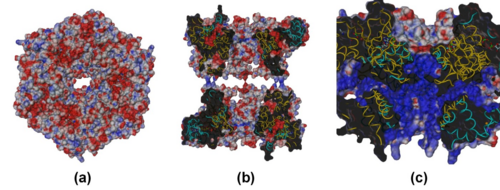RuvBL1/RuvBL2 complex (ATPase)
From Proteopedia
(Difference between revisions)
m (started) |
m |
||
| Line 1: | Line 1: | ||
| + | <StructureSection load='RuvBL12_12mer.pdb' size='400' side='right' scene='Journal:JSB:1/Cv/2' caption='An ATPase, Human RuvB-like 1 dodecamer complex with ADP (PDB code [[2c9o]])'> | ||
'''Structural and functional insights into a dodecameric molecular machine – The RuvBL1/RuvBL2 complex (ATPase)<ref >PMID: 21933716</ref>'''<br /> | '''Structural and functional insights into a dodecameric molecular machine – The RuvBL1/RuvBL2 complex (ATPase)<ref >PMID: 21933716</ref>'''<br /> | ||
<scene name='Journal:JSB:1/Al/1'>RuvBL1</scene> (RuvB-like 1; [[2c9o]] <ref>PMID: 17060327</ref>; <font color='magenta'><b>colored magenta</b></font>) and its homolog RuvBL2 are evolutionarily highly conserved AAA+ '''ATPases''' essential for many cellular activities. They play an important role in chromatin remodeling, transcriptional regulation and DNA damage repair. RuvBL1 and RuvBL2 are overexpressed in different types of cancer and interact with major oncogenic factors, such as β-catenin and c-myc regulating their function. Since the full-length complex did not crystallize, <scene name='Journal:JSB:1/Al/6'>mutants of RuvBL1 and RuvBL2 with a two-thirds truncation of the flexible domain II</scene> were generated: <scene name='Journal:JSB:1/Al/3'>RuvBL1deltaDII</scene> <font color='darkmagenta'><b>(R1∆DII)</b></font> and <scene name='Journal:JSB:1/Al/5'>RuvBL2deltaDII</scene> <span style="color:cyan;background-color:black;font-weight:bold;">(R2∆DII)</span>. Crystals of the selenomethionine derivative of the R1∆DII/R2∆DII complex diffracted to 3 Å resolution and led to the determination of the three-dimensional structure of the complex. The structure reveals a <scene name='Journal:JSB:1/Cv/2'>dodecamer consisting of two heterohexameric rings with alternating RuvBL1 and RuvBL2 monomers</scene> (the <font color='darkmagenta'><b>RuvBL1</b></font> and the <span style="color:cyan;background-color:black;font-weight:bold;">RuvBL2</span> <scene name='Journal:JSB:1/Cv/3'>monomers in the dodecamer</scene> are colored <font color='darkmagenta'><b>darkmagenta</b></font> and <span style="color:cyan;background-color:black;font-weight:bold;">cyan</span>, respectively) bound to ADP/ATP (click on <scene name='Journal:JSB:1/Cv/5'>RuvBL1 </scene> or, alternatively on <scene name='Journal:JSB:1/Cv/6'>RuvBL2</scene> to see protein/nucleotide interactions). The two heterohexamers interact with each other via the retained part of domain II, which is however poorly visible in the electron density maps, probably because the complex was not crystallized in a single conformational state. This is also hinted by evidence that in the RuvBL1 monomers, ATP was partly hydrolyzed to ADP. The dodecameric quaternary structure of the R1ΔDII/R2ΔDII complex observed in the crystal structure was confirmed by small-angle X-ray scattering analysis. RuvBL1 and RuvBL2 share <scene name='Journal:JSB:1/Al/7'>43 % sequence identity and 65 % sequence similarity and therefore the 3D structures of R1deltaDII and R2deltaDII are very similar</scene>. Due to the low data resolution, and even though the crystal structure could be solved by molecular replacement using a truncated RuvBL1 model, the use of a selenomethionine derivative was essential to elucidate the complex composition, since only one methionine residue is conserved out of 11 in R1ΔDII and 12 in R2ΔDII. | <scene name='Journal:JSB:1/Al/1'>RuvBL1</scene> (RuvB-like 1; [[2c9o]] <ref>PMID: 17060327</ref>; <font color='magenta'><b>colored magenta</b></font>) and its homolog RuvBL2 are evolutionarily highly conserved AAA+ '''ATPases''' essential for many cellular activities. They play an important role in chromatin remodeling, transcriptional regulation and DNA damage repair. RuvBL1 and RuvBL2 are overexpressed in different types of cancer and interact with major oncogenic factors, such as β-catenin and c-myc regulating their function. Since the full-length complex did not crystallize, <scene name='Journal:JSB:1/Al/6'>mutants of RuvBL1 and RuvBL2 with a two-thirds truncation of the flexible domain II</scene> were generated: <scene name='Journal:JSB:1/Al/3'>RuvBL1deltaDII</scene> <font color='darkmagenta'><b>(R1∆DII)</b></font> and <scene name='Journal:JSB:1/Al/5'>RuvBL2deltaDII</scene> <span style="color:cyan;background-color:black;font-weight:bold;">(R2∆DII)</span>. Crystals of the selenomethionine derivative of the R1∆DII/R2∆DII complex diffracted to 3 Å resolution and led to the determination of the three-dimensional structure of the complex. The structure reveals a <scene name='Journal:JSB:1/Cv/2'>dodecamer consisting of two heterohexameric rings with alternating RuvBL1 and RuvBL2 monomers</scene> (the <font color='darkmagenta'><b>RuvBL1</b></font> and the <span style="color:cyan;background-color:black;font-weight:bold;">RuvBL2</span> <scene name='Journal:JSB:1/Cv/3'>monomers in the dodecamer</scene> are colored <font color='darkmagenta'><b>darkmagenta</b></font> and <span style="color:cyan;background-color:black;font-weight:bold;">cyan</span>, respectively) bound to ADP/ATP (click on <scene name='Journal:JSB:1/Cv/5'>RuvBL1 </scene> or, alternatively on <scene name='Journal:JSB:1/Cv/6'>RuvBL2</scene> to see protein/nucleotide interactions). The two heterohexamers interact with each other via the retained part of domain II, which is however poorly visible in the electron density maps, probably because the complex was not crystallized in a single conformational state. This is also hinted by evidence that in the RuvBL1 monomers, ATP was partly hydrolyzed to ADP. The dodecameric quaternary structure of the R1ΔDII/R2ΔDII complex observed in the crystal structure was confirmed by small-angle X-ray scattering analysis. RuvBL1 and RuvBL2 share <scene name='Journal:JSB:1/Al/7'>43 % sequence identity and 65 % sequence similarity and therefore the 3D structures of R1deltaDII and R2deltaDII are very similar</scene>. Due to the low data resolution, and even though the crystal structure could be solved by molecular replacement using a truncated RuvBL1 model, the use of a selenomethionine derivative was essential to elucidate the complex composition, since only one methionine residue is conserved out of 11 in R1ΔDII and 12 in R2ΔDII. | ||
| Line 6: | Line 7: | ||
{{Clear}} | {{Clear}} | ||
Our data give new insights into the molecular arrangement of RuvBL1 and RuvBL2 and strongly suggest that in vivo activities of these highly interesting therapeutic drug targets are regulated by cofactors inducing conformational changes via domain II in order to modulate the enzyme complex into its active state. | Our data give new insights into the molecular arrangement of RuvBL1 and RuvBL2 and strongly suggest that in vivo activities of these highly interesting therapeutic drug targets are regulated by cofactors inducing conformational changes via domain II in order to modulate the enzyme complex into its active state. | ||
| + | |||
| + | </StructureSection> | ||
Revision as of 21:09, 12 February 2016
| |||||||||||

